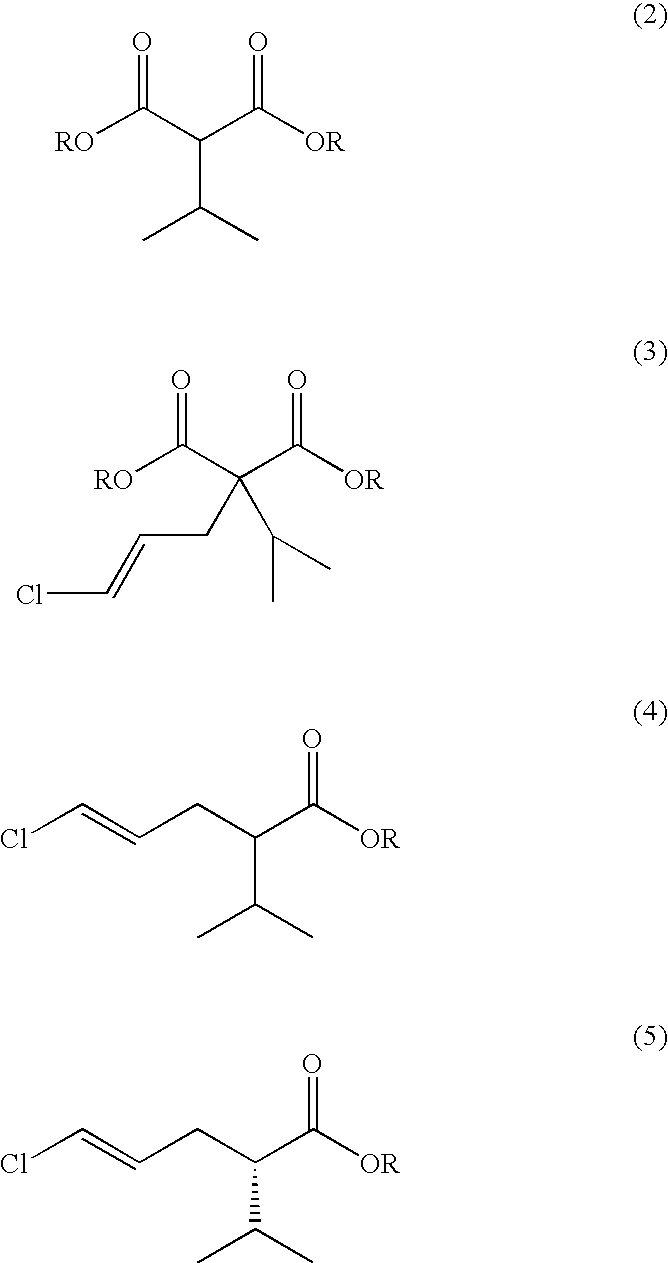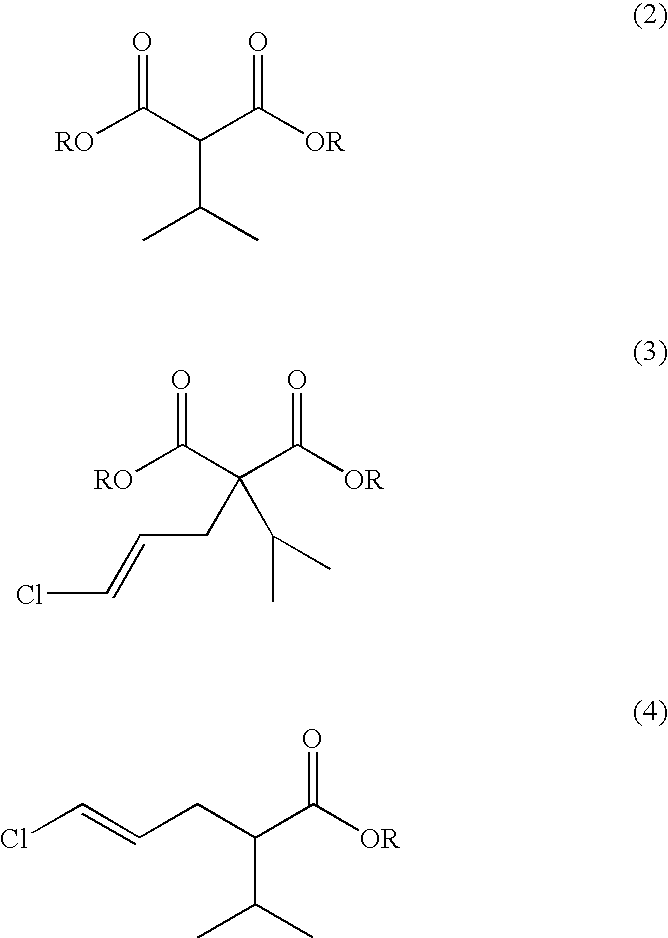Process for producing (4E)-5-chloro-2-isopropyl-4-pentenoate and optically active form thereof
- Summary
- Abstract
- Description
- Claims
- Application Information
AI Technical Summary
Benefits of technology
Problems solved by technology
Method used
Image
Examples
example 1
Example (1) of Synthesis of Methyl (4E)-5-chloro-2-isopropyl-4-pentenoate
[0090] Step (a):
[0091] A 5 L flask equipped with a stirrer, a thermometer, a condenser and a distilling apparatus was loaded with 28% NaOCH3 in methanol (373.8 g), toluene (1250 ml), dimethylformamide (375 ml), and dimethyl malonate (250 g) in toluene (375 ml) was added thereto dropwise. The resulting mixture was gradually heated while the methanol formed as a by-product and the methanol originating from the 28% NaOCH3 in methanol were removed. The distillate obtained under heating was analyzed by GC, and the heating was stopped when the methanol content of the distillate reached 1% or below. After the system was cooled to 80-90° C., isopropyl bromide (264.8 g) in toluene (375 ml) was added, and then, the system was heated with stirring for 20 hours. After confirmation of almost complete disappearance of the starting materials by GC, methanol (200 ml) was added, and the system was heated gradually to remove t...
example 2
Example (2) of Synthesis of Methyl (4E)-5-chloro-2-isopropyl-4-pentenoate
[0100] Step (c):
[0101] Dimethyl 2-[(2E)-3-chloro-2-propenyl]-2-isopropylmalonate (10 g) obtained in the step (b) in Example 1 was heated with sulfolane (102 ml), H2O (1 g) and NaCl (3.5 g) to 225° C. and then stirred for 13 hours until completion of the reaction was confirmed by GC. The reaction system was cooled and evaporated under reduced pressure to give crude methyl (4E)-5-chloro-2-isopropyl-4-pentenoate (12.1 g). The crude product afforded methyl (4E)-5-chloro-2-isopropyl-4-pentenoate (10 g) after dilution with IPE and removal of the residual sulfolane by washing with water. NMR analysis of the product agreed with the data obtained in Example 1. The product of the step (c) did not contain the Z-isomer.
example 3
Example (1) of Enzymatic Optical Resolution of Methyl (4E)-5-chloro-2-isopropyl-4-pentenoate
[0102] To a solution of 614 Units of porcine liver esterase (Roche Diagnostics, Technical Grade) in phosphate buffer (pH 7.0, 5 mmol / l, 230 mL) maintained at 35-40° C., racemic methyl (4E)-5-chloro-2-isopropyl-4-pentenoate (20 g) obtained in the same manner as in Example 2 was fed at a rate of 0.065 g / min with a tubing pump, while the reaction system was stirred with a stirring blade to disperse the starting material throughout the reaction system. After the starting material was fed continuously over 5 hours and 10 minutes, the reaction was continued for 21 hours under the same conditions. The starting material was fed to a total concentration of 8 mass %.
[0103] The reaction product was extracted with t-butyl methyl ether, and the organic layer was washed with 5% aqueous sodium carbonate to transfer (R)-(4E)-5-chloro-2-isopropyl-4-pentenoic acid into the aqueous phase. It was found by GC a...
PUM
| Property | Measurement | Unit |
|---|---|---|
| Polarity | aaaaa | aaaaa |
Abstract
Description
Claims
Application Information
 Login to View More
Login to View More - R&D Engineer
- R&D Manager
- IP Professional
- Industry Leading Data Capabilities
- Powerful AI technology
- Patent DNA Extraction
Browse by: Latest US Patents, China's latest patents, Technical Efficacy Thesaurus, Application Domain, Technology Topic, Popular Technical Reports.
© 2024 PatSnap. All rights reserved.Legal|Privacy policy|Modern Slavery Act Transparency Statement|Sitemap|About US| Contact US: help@patsnap.com










